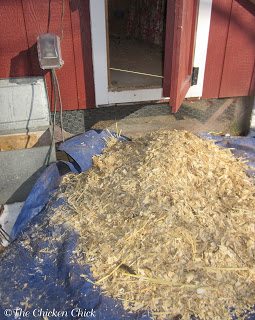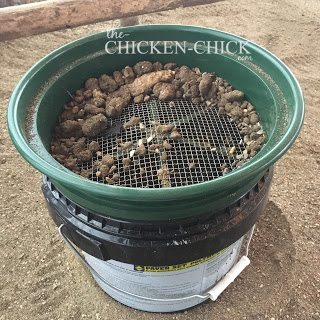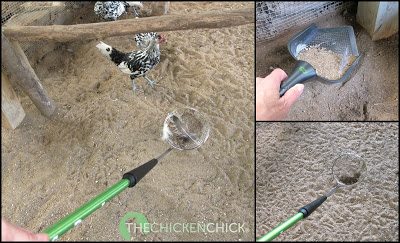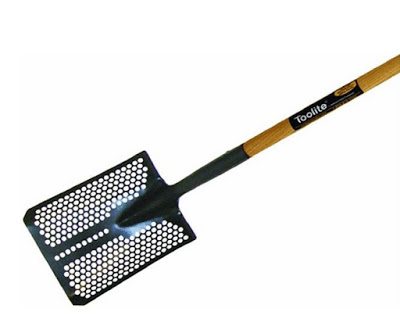For the first two years of my chicken adventures, I used pine shavings as bedding in the coop, mainly because it was a common recommendation that was readily available and fairly inexpensive. It never occurred to me to use sand in the coop, even though I used sand in the run, but when Facebook fan Kelly V. raved about the performance of sand in the coop, I already had plenty of sand on hand , so I thought it was possible. There's no harm in experimenting. Worst case scenario, I could scoop it into the barrel and use pine shavings again. Pine shavings are a good choice for cat litter, but scientific research and personal experience have proven that sand is even better!
Pine shavings should be replaced regularly because they absorb moisture and feces are mixed with them.
The main functions of the nest in backyard farmers are to maintain the stabledry and facilitate cleaningThe most common materials are soft wood shavings, chopped straw and sand. It turns out that sand is not a new or modern chicken gravel concept; using sand is a tried and true, old-fashioned way to raise laying hens.Poultry visionary, Charles Weekswrote about the benefits of sand as bedding for chickens in his 1919 book, “Egg Farming in California,” in which he stated, “Sand is the only material that can be used on the floors of poultry houses. Clean, dry sand prevents bacteria from spreading. Clean, sharp sand is tempting for dust and easy to keep clean because the feces lie on top and can be lifted easily.”
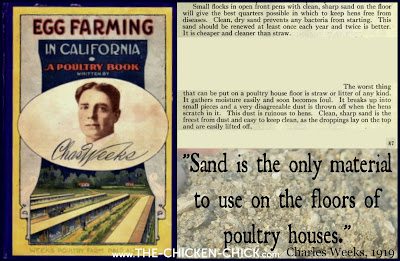
From scientific studies conducted byAuburn University Department of Poultry Science, which was confirmed by further field trials, sand performed better than pine chips with lower bacterial counts, lower fungal populations and lower moisture levels. The Auburn study says: "Inorganic sand contains few nutrients that can be used by bacteria and will therefore lead to lower bacterial counts." "In addition, sand may lack binding sites for bacteria."Straw is a poor choice for litterdue to its notorious lack of absorbency, tends to causeimpact on the crop, the tendency to form manure mats and the inability to control moisture, insects, bacteria levels and ammonia. Likewise, hardwood shavings such as beechwood should be avoided due to their tendency to harbor disease-causing fungi and because they contain toxic phenol fumes. The last thing I wanted in my house was a poop-filled mat with breathing difficulties and astomachhotel for my chickens.
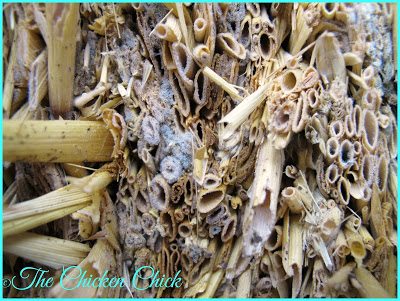
The benefits of sand are numerous. Sand dries out feces, it does not retain moisture or rot, which means less risk of respiratory infections,fly lessand other insect activity, less bacterial growth, reducedhop footinfections and a lower risk of frostbite compared to chips and straw. There is no riskimpact on the cropwith sand, sand is actually beneficial for digestive systembecause it is used as grit in the gizzard to break down fibrous food before it passes into the feces.
The high thermal mass holds sandmore stable cage temperatures; the researchers from Auburn University discovered that there are chicken coops in sandcooler in summerInwarmer in winterThe purpose of waste is to preserve the environmentdry and easy disposal of waste, it is NOT intended to keep chickens warm in cold weather! Chickens stay warm thanks to their high body temperature and feather insulation in a DRY environment. Sand achieves this goal in a unique way by creating a healthy living space in all seasons. Dry sand does NOT freeze at freezing temperatures, but...some wasteAnyone who can get wet in freezing temperatures will! Learn all about how to help chickens thrive in cold temperaturesHER.
In bad weather, the sand in the garden is dry and drystofbadfinished!Eggs in nest boxes stay cleanerin wet or muddy outdoor conditions as the chickens' feet are cleaned and dried as they walk through the sand to nest boxes.
Aesthetically, sand looks cleaner than other waste optionsiscleaner; the researchers from Auburn University found, among other things, coliform bacteriaAnd coli, significantly lower in sandthen in wood shavings!
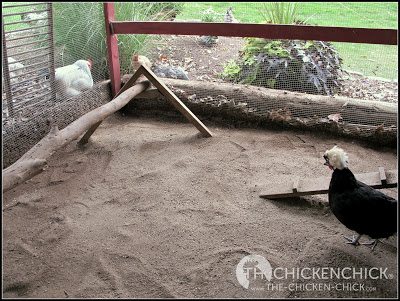
Sand is still recommended by poultry experts and veterinarians. Maryland poultry veterinarian Dr. McKillop, DVM, MSpVM, DACPV state:"Sand is a wonderful bedding/soil source for backyard poultry. I recommend all my clients to switch from wood shavings to sand. When it gets wet or rains the water drains, sand is easy to clean and is a wonderful medium for fabric bathing. Sand sinksCoccidiosisproblems because coccia need a warm, moist environment with oxygen to grow spores."Chickens can gradually acquire natural immunity to coccidiosis without contracting the enteric disease due to an overpopulation of pathogenic oocysts promoted by wet litter.

In her book,Brood and raise your own chickens, respected poultry author Gail Damerow discusses sand as brood bedding, saying, "(Sand) is not as absorbent as other types of bedding, but it absorbs heat more easily and evaporates moisture more quickly and therefore remains drier. Perhaps for the same reason, sand is more resistant to microbes than other types of bedding, keeping baby birds healthier. Dirty sand does not stick to the feet like other types of bedding. When kicked into a waterer, the sand does not float and discourages drinking, but sinks to the bottom, which keeps the water clean. When sieved periodically to remove chicken droppings, sand lasts much longer than other types of bedding, making it extremely economical.” Although it is unusual for chicks to consume bedding when feed is available, it is better to let them get used to starter feed for a few days before putting bedding in the brooder and opting for paper towels instead.
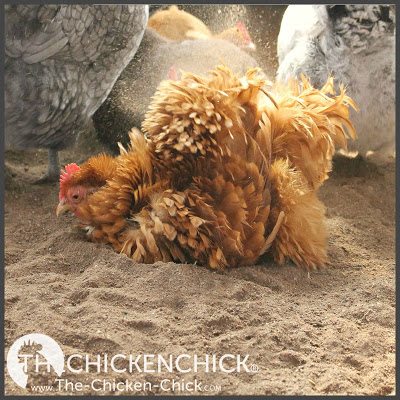

THE IMPORTANCE OF SAND TYPE
Propersand typegoes by many different names: washed sand, washed construction sand, bank sand, river sand, riding sand, arena sand, etc. The construction company I get my sand from has changed what they call it from year to year, so if you buy sand,it is better to see or describe the desired product rather than insisting on a specific name. Sand for use as chicken bedding andfabric bathingmust be washed, natural and consist ofvariable particle sizes. It should bedoesn'tproduced by crushing quartz. Much play sand is made by grinding quartz, which creates fine, dusty particles that hold tightly together, neither of which are desirable qualities for chicken bedding.

Sand can be purchased in bulk relatively cheaply from local quarries. Each community has a local source of sand for use in construction and landscaping projects. Garden centers, landscaping and construction companies are all good sources. Home improvement centers usually have bags of sand at a less affordable price than bulk sand, but care must be taken to ensure that the sand is natural and not manufactured. I amnot a fan of the bagged sand found at Home Depot & Lowes;it is usually very dusty even though the bag claims it has been washed.
Freshly delivered sand is usually moist because it has been washed and stored outside. In warm weather it dries quickly; Raking the sand a few times a day will facilitate drying.
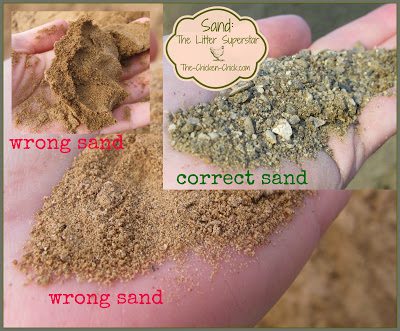
TIPS FOR USING SAND
The drier and cleaner a stable is kept, the healthier the environment for the herd. It is infinitely better with all types of cat litterdoesn'tto keep the herd's drinking water within the garden! Encourage outdoor activities and a healthy home by placing water and feed in the chicken coop, which should also eliminate anything possiblerodent activityand reducefly populationsignificantly in co-op. Chickens are grazers, they need to eat and drink at small intervals throughout the day; if food and water are kept in the coop, the chickens must come and go (literally and figuratively) in the coop all day long. Chickens waste water and feed and will fry inside all day if there is food and water in the coop, creating a much dirtier environment than if the food and water are kept outside.
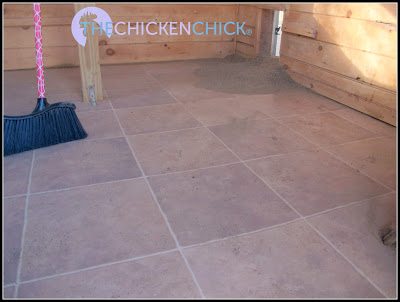
Sand can be used on chicken coop floors that are cement, dirt or wood. Inexpensive linoleum placed on hardwood floors before adding sand protects the wood beneath. I use about 4 inches of sand in the coop and as much as a foot in the coop. More is better!
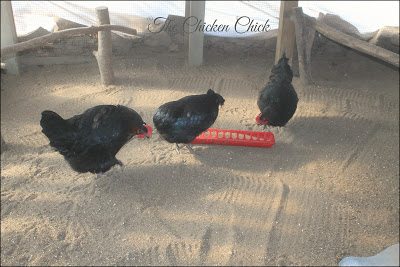
I highly recommend usingstool planksunder the living room to minimize the amount of stool in the garden. Springboards are essentially a board that collects the droppings of chickens that roost at night. Waste planks are usually scraped into a bucket early in the morning and then compost is added to it. Then I apply a thin layerSweet Coop®to absorb any remaining moisture on the stool boards, creating an inhospitable environment for flies and ammonia formation!
Any stray droppings found in the garden can be easily removed with onecat litter balland/or onegoal.
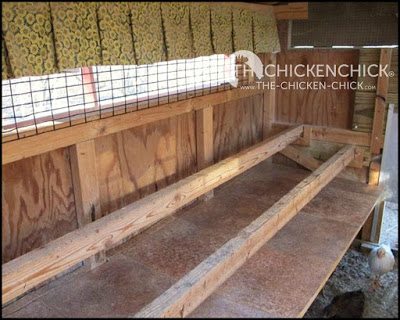
Sweet Coop®is a phenomenal tool in maintaining a dry, fly-free chicken! I use it every time I clean the planks of my stool to remove any remaining moisture. Bonus: It works as a slow-release fertilizer in the garden after composting with feces!
Using sand in the chicken coop or garden is ideal in particularly wet climates because water drains through the sand instead of creating mud puddles filled with decomposition.strawor wood shavings. Cover or cover the chicken coop to keep the sand dry and give the flock an outdoor oasisbad weather. If the sand in the chicken coop becomes wet due to drinking water, snow or rain, use arotor handlebarsor shovel to rotate facilitates drying and keeps the sand fresh and moving.

Sand added to the chicken coop before adding the walls and roof.
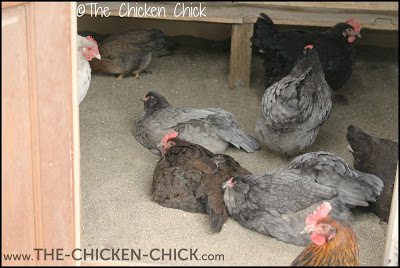
THE CHICKEN COOP
Our chicken coop is covered with a roof, but with open sides the rain occasionally wets the sand. It is normal. If that happens, I use a shovel to turn it, orrotor handlebarsto freshen it up. Because it dries so quickly, it breaks easily once turned over.
Sweet Coop® zeoliteadded to biodegradable cat litter and sprinkled on cleaned litter boxes helps further control moisture, possible ammonia odors and flies. Much more information about the benefits ofSweet Coop® zeoliteHER.
The only disadvantage of sand is its weight. Sand is heavy and may not be a viable option for chicken coops with limited physical limitations or largerchicken tractors.

ADVANTAGES OF SAND WITHIN THE MEN AN OVERVIEW
- dries feces
- does not retain moisture
- does not decay or break down in the garden
- superior drainage
- cheap
- Environmentally friendly
- natural gravel
- no risk of thatimpact on the cropLike withstrawand hay
- easy daily maintenance
- rarely is a thorough cleaning necessary
- keeps feet clean andnails cared for
- cleaner feet=cleaner eggs
- All lost food is eaten and is not lost in the nest
- stofbadMecca!
- no breakdown required in compost pile/major soil amendment, especially in clay heavy soils
- holds housescooler in summer and warmer insidewinterdue to the high thermal mass
- reduces the risk offrostbite
- looks cleaner than other waste options and alliscleaner than other waste options
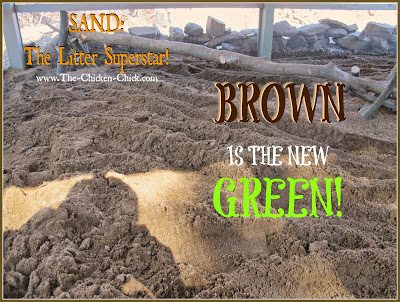
Disadvantages of sand in cages
- heavy to move
- dusty, but they are also pine shavings,straw…and chickens for that matter!
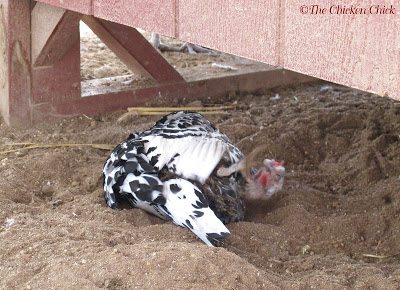
One of the advantages of sand in a covered run is that chickens canfabric bathingthroughout the year. Dry sandy loam remains loose even in the coldest temperatures. The photo above was taken in the middlewinterfor a week with temperatures below freezing.
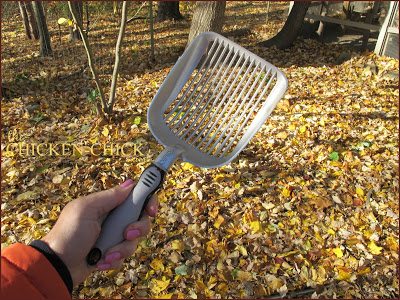
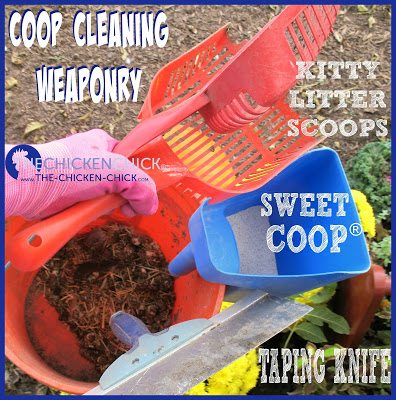
COOP CLEANING TOOL
12" plasterboard tape knife, Incorner sand scooper here.Sieve scoop,and sandstrainer pansquickly put sand in the garden and drive.
click herefor 5 tips for a cleaner chicken coop with less effort
Sandscoops

References and further reading
Testimonials from chicken keepers:
Facebook-thread #1
Facebook-thread #2
Facebook-thread #3
Facebook-thread #4
Facebook-thread #5
Egg farming in California,
Weeks, Charles, San Francisco, Schwabacher-Frey Stationery Co., 1921
Sand as bedding for keeping broilers
S.F. Bilgili, JB Hess, JP Blake, KS Macklin en JL Sibley, Auburn University, 2005 J. Appl. Kuiken. Res. 14:238:-245.
Sand as an alternative waste material, University of Kentucky 2008
Keeping backyard chickens in North Carolina. NC State University (Sand as breeding bedding and "a perfect ground cover")
How to make sand
Small Flock Series: Management of a Family Laying Flock, University of Missouri Extension
Brood and raise your own chickens,Gail Damerow (Publishing Floors, 2013)
American Veterinary Medical Association
Chicken waste choice: "Straw should be checked for mold or contamination before use. Hay is not suitable due to harmful mold spores and dust."
Alternative Wastes for Poultry Farming, Jesse L. Grimes, Turkey Extension Specialist
Kathy Shea Mormino
Kathy Shea Mormino, known internationally as The Chicken Chick®, shares a fun, informative style for raising backyard chickens.…Read more
shop my SPONSORS
For the first two years of my chicken adventures, I used pine shavings as bedding in the coop, mainly because it was a common recommendation that was readily available and fairly inexpensive. It never occurred to me to use sand in the coop, even though I used sand in the run, but when Facebook fan Kelly V. raved about the performance of sand in the coop, I already had plenty of sand on hand , so I thought it was possible. There's no harm in experimenting. Worst case scenario, I could scoop it into the barrel and use pine shavings again. Pine shavings are a good choice for cat litter, but scientific research and personal experience have proven that sand is even better!
Pine shavings should be replaced regularly because they absorb moisture and feces are mixed with them.
The main functions of the nest in backyard farmers are to maintain the stabledry and facilitate cleaningThe most common materials are soft wood shavings, chopped straw and sand. It turns out that sand is not a new or modern chicken gravel concept; using sand is a tried and true, old-fashioned way to raise laying hens.Poultry visionary, Charles Weekswrote about the benefits of sand as bedding for chickens in his 1919 book, “Egg Farming in California,” in which he stated, “Sand is the only material that can be used on the floors of poultry houses. Clean, dry sand prevents bacteria from spreading. Clean, sharp sand is tempting for dust and easy to keep clean because the feces lie on top and can be lifted easily.”

From scientific studies conducted byAuburn University Department of Poultry Science, which was confirmed by further field trials, sand performed better than pine chips with lower bacterial counts, lower fungal populations and lower moisture levels. The Auburn study says: "Inorganic sand contains few nutrients that can be used by bacteria and will therefore lead to lower bacterial counts." "In addition, sand may lack binding sites for bacteria."Straw is a poor choice for litterdue to its notorious lack of absorbency, tends to causeimpact on the crop, the tendency to form manure mats and the inability to control moisture, insects, bacteria levels and ammonia. Likewise, hardwood shavings such as beechwood should be avoided due to their tendency to harbor disease-causing fungi and because they contain toxic phenol fumes. The last thing I wanted in my house was a poop-filled mat with breathing difficulties and astomachhotel for my chickens.

The benefits of sand are numerous. Sand dries out feces, it does not retain moisture or rot, which means less risk of respiratory infections,fly lessand other insect activity, less bacterial growth, reducedhop footinfections and a lower risk of frostbite compared to chips and straw. There is no riskimpact on the cropwith sand, sand is actually beneficial for digestive systembecause it is used as grit in the gizzard to break down fibrous food before it passes into the feces.
The high thermal mass holds sandmore stable cage temperatures; the researchers from Auburn University discovered that there are chicken coops in sandcooler in summerInwarmer in winterThe purpose of waste is to preserve the environmentdry and easy disposal of waste, it is NOT intended to keep chickens warm in cold weather! Chickens stay warm thanks to their high body temperature and feather insulation in a DRY environment. Sand achieves this goal in a unique way by creating a healthy living space in all seasons. Dry sand does NOT freeze at freezing temperatures, but...some wasteAnyone who can get wet in freezing temperatures will! Learn all about how to help chickens thrive in cold temperaturesHER.
In bad weather, the sand in the garden is dry and drystofbadfinished!Eggs in nest boxes stay cleanerin wet or muddy outdoor conditions as the chickens' feet are cleaned and dried as they walk through the sand to nest boxes.
Aesthetically, sand looks cleaner than other waste optionsiscleaner; the researchers from Auburn University found, among other things, coliform bacteriaAnd coli, significantly lower in sandthen in wood shavings!

Sand is still recommended by poultry experts and veterinarians. Maryland poultry veterinarian Dr. McKillop, DVM, MSpVM, DACPV state:"Sand is a wonderful bedding/soil source for backyard poultry. I recommend all my clients to switch from wood shavings to sand. When it gets wet or rains the water drains, sand is easy to clean and is a wonderful medium for fabric bathing. Sand sinksCoccidiosisproblems because coccia need a warm, moist environment with oxygen to grow spores."Chickens can gradually acquire natural immunity to coccidiosis without contracting the enteric disease due to an overpopulation of pathogenic oocysts promoted by wet litter.

In her book,Brood and raise your own chickens, respected poultry author Gail Damerow discusses sand as brood bedding, saying, "(Sand) is not as absorbent as other types of bedding, but it absorbs heat more easily and evaporates moisture more quickly and therefore remains drier. Perhaps for the same reason, sand is more resistant to microbes than other types of bedding, keeping baby birds healthier. Dirty sand does not stick to the feet like other types of bedding. When kicked into a waterer, the sand does not float and discourages drinking, but sinks to the bottom, which keeps the water clean. When sieved periodically to remove chicken droppings, sand lasts much longer than other types of bedding, making it extremely economical.” Although it is unusual for chicks to consume bedding when feed is available, it is better to let them get used to starter feed for a few days before putting bedding in the brooder and opting for paper towels instead.


THE IMPORTANCE OF SAND TYPE
Propersand typegoes by many different names: washed sand, washed construction sand, bank sand, river sand, riding sand, arena sand, etc. The construction company I get my sand from has changed what they call it from year to year, so if you buy sand,it is better to see or describe the desired product rather than insisting on a specific name. Sand for use as chicken bedding andfabric bathingmust be washed, natural and consist ofvariable particle sizes. It should bedoesn'tproduced by crushing quartz. Much play sand is made by grinding quartz, which creates fine, dusty particles that hold tightly together, neither of which are desirable qualities for chicken bedding.

Sand can be purchased in bulk relatively cheaply from local quarries. Each community has a local source of sand for use in construction and landscaping projects. Garden centers, landscaping and construction companies are all good sources. Home improvement centers usually have bags of sand at a less affordable price than bulk sand, but care must be taken to ensure that the sand is natural and not manufactured. I amnot a fan of the bagged sand found at Home Depot & Lowes;it is usually very dusty even though the bag claims it has been washed.
Freshly delivered sand is usually moist because it has been washed and stored outside. In warm weather it dries quickly; Raking the sand a few times a day will facilitate drying.

TIPS FOR USING SAND
The drier and cleaner a stable is kept, the healthier the environment for the herd. It is infinitely better with all types of cat litterdoesn'tto keep the herd's drinking water within the garden! Encourage outdoor activities and a healthy home by placing water and feed in the chicken coop, which should also eliminate anything possiblerodent activityand reducefly populationsignificantly in co-op. Chickens are grazers, they need to eat and drink at small intervals throughout the day; if food and water are kept in the coop, the chickens must come and go (literally and figuratively) in the coop all day long. Chickens waste water and feed and will fry inside all day if there is food and water in the coop, creating a much dirtier environment than if the food and water are kept outside.

Sand can be used on chicken coop floors that are cement, dirt or wood. Inexpensive linoleum placed on hardwood floors before adding sand protects the wood beneath. I use about 4 inches of sand in the coop and as much as a foot in the coop. More is better!

I highly recommend usingstool planksunder the living room to minimize the amount of stool in the garden. Springboards are essentially a board that collects the droppings of chickens that roost at night. Waste planks are usually scraped into a bucket early in the morning and then compost is added to it. Then I apply a thin layerSweet Coop®to absorb any remaining moisture on the stool boards, creating an inhospitable environment for flies and ammonia formation!
Any stray droppings found in the garden can be easily removed with onecat litter balland/or onegoal.

Sweet Coop®is a phenomenal tool in maintaining a dry, fly-free chicken! I use it every time I clean the planks of my stool to remove any remaining moisture. Bonus: It works as a slow-release fertilizer in the garden after composting with feces!
Using sand in the chicken coop or garden is ideal in particularly wet climates because water drains through the sand instead of creating mud puddles filled with decomposition.strawor wood shavings. Cover or cover the chicken coop to keep the sand dry and give the flock an outdoor oasisbad weather. If the sand in the chicken coop becomes wet due to drinking water, snow or rain, use arotor handlebarsor shovel to rotate facilitates drying and keeps the sand fresh and moving.

Sand added to the chicken coop before adding the walls and roof.

THE CHICKEN COOP
Our chicken coop is covered with a roof, but with open sides the rain occasionally wets the sand. It is normal. If that happens, I use a shovel to turn it, orrotor handlebarsto freshen it up. Because it dries so quickly, it breaks easily once turned over.
Sweet Coop® zeoliteadded to biodegradable cat litter and sprinkled on cleaned litter boxes helps further control moisture, possible ammonia odors and flies. Much more information about the benefits ofSweet Coop® zeoliteHER.
The only disadvantage of sand is its weight. Sand is heavy and may not be a viable option for chicken coops with limited physical limitations or largerchicken tractors.

ADVANTAGES OF SAND WITHIN THE MEN AN OVERVIEW
- dries feces
- does not retain moisture
- does not decay or break down in the garden
- superior drainage
- cheap
- Environmentally friendly
- natural gravel
- no risk of thatimpact on the cropLike withstrawand hay
- easy daily maintenance
- rarely is a thorough cleaning necessary
- keeps feet clean andnails cared for
- cleaner feet=cleaner eggs
- All lost food is eaten and is not lost in the nest
- stofbadMecca!
- no breakdown required in compost pile/major soil amendment, especially in clay heavy soils
- holds housescooler in summer and warmer insidewinterdue to the high thermal mass
- reduces the risk offrostbite
- looks cleaner than other waste options and alliscleaner than other waste options

Disadvantages of sand in cages
- heavy to move
- dusty, but they are also pine shavings,straw…and chickens for that matter!

One of the advantages of sand in a covered run is that chickens canfabric bathingthroughout the year. Dry sandy loam remains loose even in the coldest temperatures. The photo above was taken in the middlewinterfor a week with temperatures below freezing.


COOP CLEANING TOOL
12" plasterboard tape knife, Incorner sand scooper here.Sieve scoop,and sandstrainer pansquickly put sand in the garden and drive.
click herefor 5 tips for a cleaner chicken coop with less effort
Sandscoops

References and further reading
Testimonials from chicken keepers:
Facebook-thread #1
Facebook-thread #2
Facebook-thread #3
Facebook-thread #4
Facebook-thread #5
Egg farming in California,
Weeks, Charles, San Francisco, Schwabacher-Frey Stationery Co., 1921
Sand as bedding for keeping broilers
S.F. Bilgili, JB Hess, JP Blake, KS Macklin en JL Sibley, Auburn University, 2005 J. Appl. Kuiken. Res. 14:238:-245.
Sand as an alternative waste material, University of Kentucky 2008
Keeping backyard chickens in North Carolina. NC State University (Sand as breeding bedding and "a perfect ground cover")
How to make sand
Small Flock Series: Management of a Family Laying Flock, University of Missouri Extension
Brood and raise your own chickens,Gail Damerow (Publishing Floors, 2013)
American Veterinary Medical Association
Chicken waste choice: "Straw should be checked for mold or contamination before use. Hay is not suitable due to harmful mold spores and dust."
Alternative Wastes for Poultry Farming, Jesse L. Grimes, Turkey Extension Specialist
562Comments
Inline-feedback
View all comments
Margot Pringle
8 months ago
I would like to buy some
Answer
Pin
1 year ago
We are beginners with 6 week old chicks. We have to raise our coop and run because of a rolling hill nearby and muddy ground when it rains. What do you recommend to apply as a foundation/first layer, so that all rainwater can drain? We think gravel? So sand on it? Thank you!
Answer
Auteur
Answer toPin
1 year ago
WHERE. Only sand. DEEP. Do not mix anything into or under the sand.
Answer
Brian
2 years ago
You've probably answered this before, but what do you do with the sand in the garden after your annual cleaning?
Answer
Cathy
2 years ago
Hello! Would beach sand work? I'm completely new to this! Our beach sand has a fine structure...
Answer
Auteur
Answer toCathy
2 years ago
No, beach sand is not suitable. The sand should have a varied texture and not be hom*ogeneous. Salt can kill chickens if consumed in sufficient quantities. Beach sand may also not be removed from the beach for environmental reasons.
Answer
Shannon
2 years ago
Hello Kathy,
May I ask which supplier you buy your sand from? I also live in CT.
Answer
